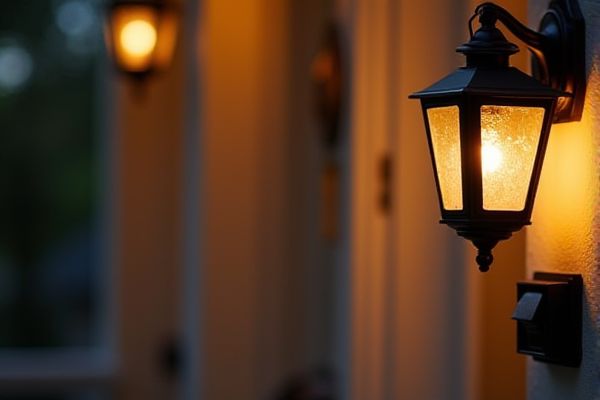
Stationary lanterns provide consistent, ambient lighting ideal for creating a cozy atmosphere, while motion sensor lights enhance security by activating only when movement is detected, conserving energy. Discover which lighting option best suits your needs in the rest of this article.
Table of Comparison
| Feature | Stationary Lantern | Motion Sensor Light |
|---|---|---|
| Operation | Constant illumination when switched on | Activates light upon detecting motion |
| Energy Consumption | Continuous energy use | Energy-efficient; lights only when needed |
| Use Case | Ideal for steady lighting in fixed areas | Best for security and automatic lighting |
| Installation | Simple, fixed installation | Requires sensor positioning and calibration |
| Cost | Generally lower upfront cost | Higher initial cost due to sensors |
| Maintenance | Minimal; basic bulb replacement | Regular sensor cleaning and occasional recalibration |
| Security | No automatic security feature | Enhances security by deterring intruders |
Introduction to Outdoor Lighting Options
Outdoor lighting options include stationary lanterns and motion sensor lights, each offering unique benefits for your property's security and ambiance. Stationary lanterns provide constant illumination with classic aesthetic appeal, enhancing pathways and entryways. Motion sensor lights activate only when movement is detected, improving energy efficiency and deterring intruders effectively.
What is a Stationary Lantern?
A stationary lantern is a fixed lighting device designed to provide consistent illumination in a specific area, often used for outdoor settings like patios, pathways, or gardens. These lanterns operate continuously or on a timer, offering a reliable light source without reacting to movement. Unlike motion sensor lights, stationary lanterns do not activate based on presence, making them ideal for creating ambient lighting and enhancing aesthetic appeal.
Understanding Motion Sensor Lights
Motion sensor lights automatically activate when detecting movement, enhancing security and energy efficiency by illuminating only when necessary. Stationary lanterns provide constant light regardless of activity, making them ideal for consistent visibility but less effective in conserving power. Understanding motion sensor technology helps you choose the best lighting option for safety and energy savings.
Energy Efficiency Comparison
Motion sensor lights significantly outperform stationary lanterns in energy efficiency by activating only when movement is detected, reducing unnecessary power consumption. Stationary lanterns remain continuously illuminated, leading to higher electricity usage and increased energy costs. Utilizing motion sensors can cut energy consumption by up to 70%, making them a more sustainable choice for lighting.
Installation and Maintenance Differences
Stationary lanterns typically require straightforward installation with fixed wiring or plug-in options, making them suitable for consistent lighting needs with minimal setup time. Motion sensor lights involve more complex installation, often requiring precise placement and wiring to ensure sensors detect movement effectively, which may demand professional assistance. Maintenance for stationary lanterns usually centers on bulb replacement and occasional cleaning, while motion sensor lights need periodic sensor calibration and battery checks to maintain optimal sensitivity and performance.
Security and Safety Benefits
Motion sensor lights enhance security by automatically illuminating areas when movement is detected, deterring potential intruders and increasing visibility during nighttime. Stationary lanterns provide consistent, reliable lighting that ensures pathways and entryways remain well-lit, reducing the risk of accidents and enhancing overall safety. Combining both lighting types can create a comprehensive security solution by maintaining constant illumination while activating brighter, motion-triggered lights for unexpected activity.
Cost Considerations
Stationary lanterns generally have a lower upfront cost compared to motion sensor lights, making them a budget-friendly option for basic outdoor lighting needs. Motion sensor lights, while more expensive initially, can reduce energy consumption and extend bulb life by only activating when movement is detected, ultimately lowering long-term operating costs. Your decision should weigh the initial investment against potential energy savings and functionality based on your specific lighting requirements.
Aesthetic and Design Impact
Stationary lanterns offer a classic, timeless aesthetic that enhances outdoor spaces with warm, ambient lighting and intricate design details, making them ideal for decorative purposes. Motion sensor lights prioritize functionality over form, featuring minimalist designs optimized for security and energy efficiency rather than visual appeal. The choice between the two depends on whether the focus is on enhancing the visual ambiance or maximizing security with discreet, responsive illumination.
Use Cases: When to Choose Each Type
Stationary lanterns provide consistent illumination ideal for areas requiring steady light, such as patios, camping sites, or emergency preparedness kits. Motion sensor lights enhance security by activating only when movement is detected, making them suitable for driveways, entryways, and perimeter lighting. Selecting between the two depends on whether constant visibility or energy-efficient, responsive lighting is the priority for the intended environment.
Final Verdict: Which Suits Your Needs?
Stationary lanterns offer consistent illumination ideal for outdoor ambiance and extended use without requiring power sources or activation. Motion sensor lights conserve energy and enhance security by activating only when movement is detected, making them perfect for safety-focused areas. Choosing between the two depends on your need for continuous lighting versus energy-efficient, responsive illumination in specific zones.
 homyna.com
homyna.com